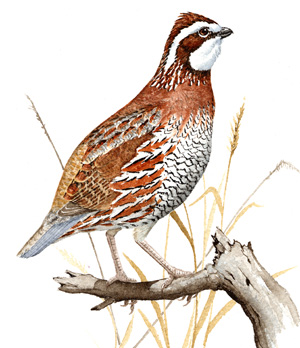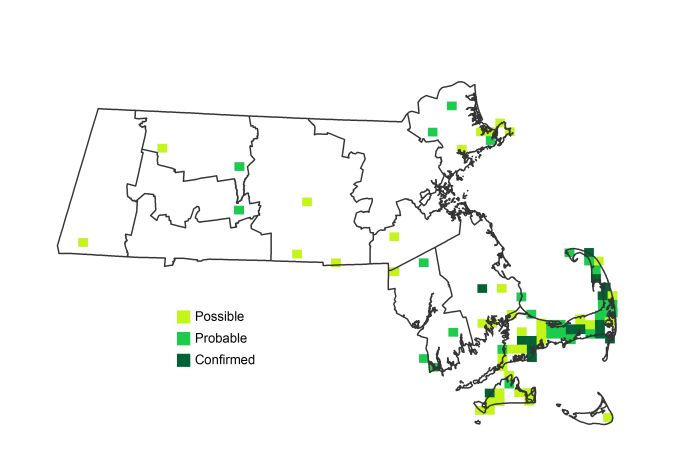Breeding Bird Atlases (BBA)
Find a Bird
Northern Bobwhite
Colinus virginianus

Local and strongly declining
Conservation action urgent
State Wildlife Action Plan listed
“The song-birds leave us at the summer's close, / Only the empty nests are left behind, / And pipings of the quail among the sheaves.” – Henry Wadsworth Longfellow, “The Harvest Moon”
The clear, whistled call of the Northern Bobwhite has long been an essential part of the summer experience in the Massachusetts countryside. These small yet charismatic birds are a favorite among hunters and birdwatchers alike, and they were historically found throughout the Commonwealth. In recent years, their numbers have declined, however; and wildlife managers are striving to save this popular species in the face of a changing landscape. Northern Bobwhites prefer open country that affords some degree of cover, such as pastures with hedgerows, overgrown fields, natural forest clearings, and even power line corridors. They will also inhabit mature forests that experience regular fire disruption. Fire, in fact, has been a key factor in maintaining the early-successional habitats that bobwhites favor.
Historic Status
Accounts of Northern Bobwhites in Massachusetts reach back to its earliest settlers. Thomas Morton of the Mount Wollaston section of Quincy wrote in 1632 of seeing 60 “quails” in a tree from his house (Forbush 1927). Morton was also the first to misname the species because it looked so much like a similar species from the Old World. By the middle of the nineteenth century, the Northern Bobwhite’s call was “as well known among the country folk as the morning carol of the Robin in the orchard, the drumming of the Ruffed Grouse in the woods or the reiterated plaint of the Whip-poor-will on the moonlit doorstone” (Forbush 1912). By 1911, despite considerable still-favorable habitat conditions, the species was already on its way out as a breeder in Massachusetts, no doubt in part a result of overhunting and restocking of non-natives (Griscom & Snyder 1955). Reforestation offered the bobwhite no favors as the century wore on.
Atlas 1 Distribution
In Atlas 1, bobwhites were present but scarce in the western part of the Commonwealth, becoming steadily more common the farther east and south one traveled. The Taconic Mountains and Marble Valleys had only just over half a dozen occupied blocks combined, while the forested Berkshire Highlands and Lower Berkshire Hills were totally devoid of bobwhites. Similarly small numbers of birds were present across the state to the eastern Worcester Plateau, where they were still thinly distributed. The Coastal Plains had 81 occupied blocks, more than four times the combined amount of all the western ecoregions. Even the well-settled Boston Basin had 10 occupied blocks, but the true center of distribution for the species was in the southeast. More than 60% of all Atlas 1 Northern Bobwhite records came from the Bristol/Narragansett Lowlands and the Cape and Islands.
Atlas 2 Distribution and Change
The shrinking trend of the Northern Bobwhite continued into Atlas 2, as the bird became increasingly difficult to find. No bobwhites were Confirmed as breeders anywhere north or west of the Bristol/Narragansett Lowlands. The few records from western and central Massachusetts most likely represented released birds rather than holdouts from the native breeding population. The Bristol/Narragansett Lowlands reported an alarmingly steep decline in bobwhite occupancy, from almost 90% in Atlas 1 to barely 5% in Atlas 2. This decline can be termed nothing less than catastrophic.
Atlas 1 Map

Atlas 2 Map

Atlas Change Map

Ecoregion Data
Atlas 1 | Atlas 2 | Change | ||||||
Ecoregion | # Blocks | % Blocks | % of Range | # Blocks | % Blocks | % of Range | Change in # Blocks | Change in % Blocks |
Taconic Mountains | 1 | 6.3 | 0.3 | 0 | 0.0 | 0.0 | -1 | -6.7 |
Marble Valleys/Housatonic Valley | 6 | 15.4 | 1.9 | 1 | 2.6 | 1.3 | -5 | -12.8 |
Berkshire Highlands | 0 | 0.0 | 0.0 | 1 | 1.8 | 1.3 | 1 | 1.9 |
Lower Berkshire Hills | 0 | 0.0 | 0.0 | 0 | 0.0 | 0.0 | 0 | 0.0 |
Vermont Piedmont | 2 | 11.8 | 0.6 | 0 | 0.0 | 0.0 | -2 | -16.7 |
Berkshire Transition | 2 | 5.3 | 0.6 | 0 | 0.0 | 0.0 | -1 | -3.2 |
Connecticut River Valley | 5 | 8.9 | 1.6 | 0 | 0.0 | 0.0 | -4 | -8.3 |
Worcester Plateau | 7 | 9.0 | 2.3 | 2 | 2.3 | 2.5 | -2 | -4.2 |
Lower Worcester Plateau | 5 | 6.8 | 1.6 | 1 | 1.3 | 1.3 | -4 | -7.4 |
S. New England Coastal Plains and Hills | 81 | 30.0 | 26.0 | 10 | 3.5 | 12.5 | -67 | -29.6 |
Boston Basin | 10 | 17.9 | 3.2 | 1 | 1.8 | 1.3 | -9 | -16.4 |
Bristol and Narragansett Lowlands | 91 | 85.8 | 29.3 | 6 | 5.3 | 7.5 | -83 | -82.2 |
Cape Cod and Islands | 101 | 74.3 | 32.5 | 58 | 40.3 | 72.5 | -47 | -39.2 |
Statewide Total | 311 | 32.1 | 100.0 | 80 | 7.7 | 100.0 | -224 | -27.0 |
Notes
The Atlas 2 data can be corroborated. In 2007, when MassWildlife ran its standard whistle count surveys, for the first time ever they failed to register even a single bobwhite call in return (MassWildlife 2008). After more than fifteen years of diminishing results, the population had seemingly all but disappeared. The loss of successional agricultural lands throughout most of Massachusetts and the return of forests in many regions has practically left bobwhites homeless. The final survivors have seemingly found solace, food, and protective underbrush only in the burn-controlled pitch pine forests of Cape Cod. Northern Bobwhites show significant decreasing Breeding Bird Survey trends in Massachusetts, the New England/Mid-Atlantic region, and the eastern US region.



